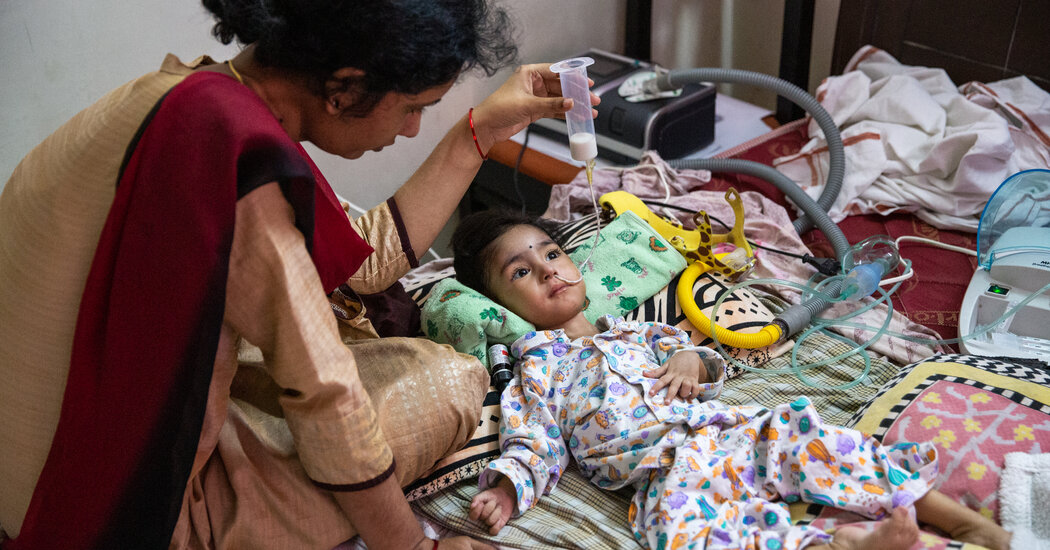In India, Parents of Children with Rare Disease Plea for Help Online
ELURU, India — When her baby started breathing, Stella Praveen had a terrible feeling that something was seriously wrong with her 14-month-old daughter, Ellen.
She ran barefoot to a nearby clinic, but the doctors there said the child needed to see a specialist right away. Without an ambulance, she jumped on the back of a motorcycle and drove 35 miles to a children’s hospital in another town, where Ellen was in intensive care for 12 days.
Two weeks later, Mrs Praveen learned that her daughter, who was never able to lift her neck or roll over, was suffering from spinal muscular atrophy, a rare condition that is often fatal by the age of 2 years.
“We hadn’t even heard of this disease,” Ms Praveen said as tears rolled down her face. “She was often misdiagnosed.”
The Praveen family was equally encouraged to learn that a promising gene therapy treatment was available, but were soon saddened to learn the cost: $2.1 million.
In India, and in many of the world’s poorer countries, the pharmaceutical industry’s latest advancements in rare diseases are often out of reach, impossible for almost anyone but the wealthiest families to pay, and not covered by health insurance.
In desperation — and encouraged by the occasional success story — families are turning to social media to raise money.
Every morning, Ellen’s father, Rayapudi Praveen, sends hundreds of emails to five crowdfunding websites such as ImpactGuru and GoFundMe, asking people to contribute money to save his daughter’s life.
“Dear Sir, My daughter Ellen is suffering,” each email begins. “Can you help us?”
With only four months to go before Ellen turns 2, time is running out – and the family is still a long way from its goal.
Spinal muscular atrophy is an inherited neuromuscular disease that kills more infants worldwide than any other genetic disorder. In India, one study estimated the prevalence at one in 7,744 live births, or about 3,200 Indian babies per year.
Symptoms for all four types of the condition show up at different stages. Infants like Ellen with type 1, the most severe, show symptoms in the first six months of life: they have trouble moving their limbs, swallowing, sucking, and eventually breathing. They usually don’t live after 2.
Across India, pediatric neurologists said, increasing parental awareness of the disease is leading to more patients being identified.
In recent years, India has developed a reputation as a low-cost manufacturing hub for multinational drugs, and the drugs made here are often significantly cheaper than imported ones, thanks in part to government price caps.
But the therapies for many rare diseases are still typically imported, forcing patients and parents to face an unbearable truth: India’s status as an emerging pharmaceutical superpower is not helping them.
In 2019, the US Food and Drug Administration approved the Zolgensma gene therapy, which alters the underlying genetic cause of spinal muscular atrophy and may permanently halt the progression of the disease.
At $2.1 million, the drug company Novartis’ Zolgensma therapy is believed to be the highest price ever set for a single treatment.
Spinraza, another drug, costs $750,000 a year the first year and $375,000 a year after that, and must be taken for a lifetime.
Updated
Apr 6, 2022, 3:09 PM ET
Neither Zolgensma nor Spinraza, made by Biogen, is manufactured in India or approved for use here, so parents import them with the help of their doctors, a process that requires special government approvals.
The only drug approved in India for the condition is Evrysdi, manufactured by Roche. It’s the cheapest of the three treatments, but it still costs $53,000 to $80,000 a year, and that’s a discounted price for India negotiated with Roche by the government.
None of these drugs are covered by insurance in India, so families face a tough choice: raise the necessary funds or watch their children languish.
So far, the Praveens have raised just over $100,000 for Ellen’s treatment, but they’re not giving up hope and their optimism isn’t entirely unfounded.
Since May 2019, when Zolgensma was introduced, the parents of at least 10 children have managed to raise 2.1 million dollars through crowdfunding.
Last year, Yogesh Gupta started a crowdfunding campaign and sent emails to everyone he knew asking for help for his son, Ayaansh, who has Type 1. Soon, a team of 125 friends, colleagues and relatives began sending social media messages to politicians and Bollywood stars. Moved by the child’s plight, the officials and celebrities not only donated money themselves, but also helped spread the word.
After three and a half months, Mr Gupta said he had raised $2.1 million.
“There is a lot of improvement,” Mr Gupta said of his son after he received Zolgensma’s treatment. “He can lift his legs slightly and the neck control is much better.”
Raman Nagumantri is more than halfway through and has raised $1.6 million for his 19-month-old daughter Khyati.
“We can’t remember a day that we’ve slept all night since she was diagnosed,” said Mr. Nagumantri. “But we’re close, and I can do anything, anything, to get those needed funds in these four months.”
For nearly all children in the world with type 1, their best chance of survival lies with the Global Managed Access Program, or gMAP, which Zolgensma provides free of charge to a select number of eligible patients under 2 years of age in countries where the gene therapy has not received regulatory approval or not covered by insurance.
Novartis representatives said more than 250 children from around the world had received the therapy for free through gMAP.
Novartis declined to share the total number of patients from India, but Dr. Ann Mathew, a leading pediatric neurologist who has more than 400 patients with spinal muscular atrophy, said 40 children had received the treatment across India in the past year, the majority through gMAP. Nineteen of her patients have taken Zolgensma in the past 13 months, 16 free and three paid.
Biogen said 200 patients in India had been given Spinraza for free.
Patient advocacy groups are pushing for government intervention to negotiate better prices with pharmaceutical companies.
“If the government intervenes, prices will automatically fall,” said Alpana Sharma, co-founder of Cure SMA, a parent-led advocacy group. “This is what happened with cancer and other rare diseases like hemophilia.”
While the parents of children with type 1 have a painfully short period of time to heal, the treatments for type 2, which have debilitating effects but are usually not fatal before adulthood, are also well beyond the reach of most health care providers.
In the coastal state of Goa, Ruby Borges and her husband, Benedict Borges, were devastated when their 5-year-old son, Dylan, was diagnosed with SMA-Type 2 three years ago. and 18 months, and children who suffer from it cannot walk.
At the time of Dylan’s diagnosis, Spinraza was the only treatment available.
After failing to get into the compassionate entry program, his parents turned to crowdfunding. Months of appeals through church groups in their communities helped raise $57,000. At that rate, it would take years to find the money to pay Spinraza, and in the meantime, Dylan grew weaker as his muscles crumbled.
Doctors advised Dylan’s parents to start him on Evrysdi. They managed to buy enough stock of that drug to last until the end of the year. Dylan’s mother feels the medication and intensive physical therapy are helping, and she said she’s seen a 20 percent improvement in his condition. But she worries about how long she can continue to rely on the generosity of strangers to keep her son alive.
“People laugh when they hear the price of the drug,” said Ms. Borges. “They’re wondering if I’m going to spend it on a car or a big house.”
Ellen’s parents need even more money and have even less time.
One recent afternoon, her father walked down a dirt road to a nearby highway, where he hitchhiked to the town of Vijayawada. Hours later, he arrived at the grand home of a businessman-philanthropist he hoped could help.
But it wasn’t supposed to be.
“Accept your fate and move on,” the businessman told him.
Mr Praveen looked through a window at the businessman’s sprawling lawn and vowed not to give up.
“I will fight until her last breath,” he said.


Comments are closed.